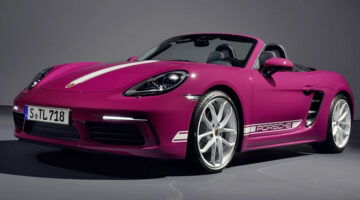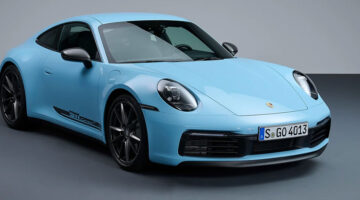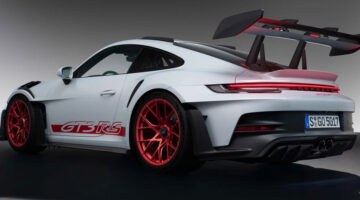As the iconic model line enters its 55th year in production the new eighth generation of the Porsche 911 has been revealed – although some will consider it the ninth if they class the original short wheelbase cars sold for the first four years of the 911’s life as a model in their own right.
Regardless, for the 992 series the new 911 has passed through an evolutionary process resulting in a car with a further stretching of its wheelbase, widening of its nose, a new PDK gearbox and further enhancements of its turbo-charged flat-six engine. Every new 911 is an important milestone, this could arguably be the most critical since the first water-cooled car was introduced two decades ago.
For the first time since the 997 generation, Porsche’s rear-engined sports car will once again only be offered in a single body size. Unfortunately this won’t be a narrow body, but rather the wider shell that had previously been the reserve of the Carrera S and GTS models. For the new 911, however, Porsche has also widened both the front track and body by some 45mm to create a far more cohesive design and improve front-end grip, stability and traction.
Despite a longer wheelbase the overall length of the 911 remains within a millimetre or two of the outgoing gen-2 991 and whilst the casual observer will need a 911 spotters guide to pick out the changes, those who follow all things 911 will spot the more subtle design details. Such as the more pronounced front wings and headlights (complete with the latest LED matrix units) and the recess in the bonnet harking back to the air-cooled days. Electronic flush fitting door handles, deeper side sills and larger rear wheel arches are all new and form part of the visual makeover.
A 911’s rear end is always its most distinctive area and the 992 is no different. The new, larger vertically-slatted engine cover houses the central high intensity brake light, there’s a wider retractable rear wing too and the rear bumper also features a wraparound LED taillight, with the former dropping sharply to create a deep flat surface with a pair of exhaust pipes exiting either side.
Packaging six-cylinders, two-turbochargers and a new eight-speed gearbox (more on this later) along with the engine’s breathing and cooling requirements hasn’t done much for the square footage of the 992’s backside. From certain angles there quite a lot of real estate to take in.
Initially Porsche’s new 911 will only be available with the one turbocharged flat-six engine – the 444bhp, 406lb ft 3.0-litre turbocharged ‘six that was previously only available in the out going Carrera GTS models. With the latest particulate filter and a new exhaust system this latest engine out performs its predecessor in terms of acceleration (3.6-secs and 3.7-secs for the Carrera S and Carrera 4S with a PDK gearbox are 0.4-seconds quicker than their predecessors), top speed (305kph or 307kph depending on the number of driven axles), fuel economy and emissions. A lower powered version of the engine will be introduced early in 2019 for the Carrera and Carrera 4 models.
While the engine has been through an incremental update process, the PDK gearbox is all new. Despite gaining an additional ratio and many of the mechanical elements having been replaced with more packaging friendly electronic components, including the shift mechanisms, it’s the same physical size as the outgoing unit. However, if you were to open it up you’d discover an unoccupied area for the electric motor required for any of the hybrid plans Porsche has for the 911 in four years time. A fully electric 911 is still some way off, circa 2028 says Porsche.
A downside for making provision for future hybrid and electric powertrains (the 992’s body has the fixings and mountings for battery packs and motors) is an increase in weight over the 991 of around 50kg (expect the Carrera 4S to weigh in at 1600kg). But fear not, despite spending a great deal of the budget on a new PDK unit, Porsche has overhauled its seven-speed manual gearbox, too. Although, like the lower powered engine you’ll have to wait until early 2019 before you can order one.
In terms of chassis, the adaptive PASM damper system is once again an option, so too the company’s Sport chassis, the former lowering the ride height by 10mm the latter by 20mm. Rear-wheel steering, torque vectoring and a mechanical limited slip-differential will also be available, but it’s the introduction of a further driver mode called ‘Wet’ that’s most intriguing.
Using sensors in the wheel arches the system monitors noise from within and detects if the surface is wet. When it does the stability control and ABS system is primed accordingly and the driver is notified, allowing them to make the call as to whether they wish to select the wet driver mode – via the rotary control on the steering wheel. Should they choose to do so, the throttle’s response is softened and the Porsche Traction Management system optimised.
The 992 is also the first 911 to be offered with different diameter wheels front to rear, with 2019’s Carrera models to be fitted with 19 and 20-inch rims respectively, the S and 4S models with 20 and 21-in items, the latter requiring those larger rear wheel arches.
The evolutionary approach to the exterior is the opposite of the new 911’s interior. Seats aside, few elements have been taken from the recent generations of 911, although the facia is inspired by the G-Series generation cars and is home to new retro designed chrome switchgear, an instrument display that features a centrally positioned analogue rev counter flanked by a pair of TFT screens.
A 10.5-inch monitor sits above the transmission tunnel for the latest infotainment system and is also where you can fine tune the car’s dynamic technology such Night Vision Assist and Emergency Assist system that’s linked to the radar cruise control and offers a low level of autonomous driving in certain conditions. The glass-finished transmission tunnel is very reminiscent of what you’ll find in a Panamera and features a gear selector that only allows you to select reverse, park, neutral or drive. If you want to change gear manually with the new PDK ‘box you’ll need to do so with the paddles behind the new, larger, steering wheel.
Available to order now, prices start from $118,855 for the Carrera S and $125,630 for the Carrera 4S.
This article originally appeared at
evo.co.uk






